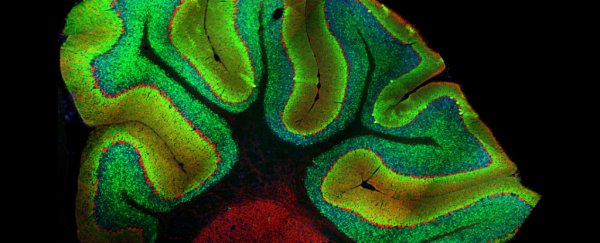One of the best-known regions of the brain, the cerebellum accounts for just 10 percent of the organ's total volume, but contains more than 50 percent of its neurons.
Despite all that processing power, it's been assumed that the cerebellum functions largely outside the realm of conscious awareness, instead coordinating physical activities like standing and breathing.
But last year neuroscientists discovered that it plays an important role in the reward response - one of the main drives that motivate and shape human behaviour.
Not only does this open up new research possibilities for the little region that has for centuries been primarily linked motor skills and sensory input, but it suggests that the neurons that make up much of the cerebellum - called granule cells - are functioning in ways we never anticipated.
"Given what a large fraction of neurons reside in the cerebellum, there's been relatively little progress made in integrating the cerebellum into the bigger picture of how the brain is solving tasks, and a large part of that disconnect has been this assumption that the cerebellum can only be involved in motor tasks," said one of the team, Mark Wagner, from Stanford University, at the time.
"I hope that this allows us to unify it with studies of more popular brain regions like the cerebral cortex, and we can put them together."
Tucked into the back of the brain, the cerebellum maintains a massive amount of connections with the motor cortex - a region of the cerebral cortex in the brain's frontal lobe that's involved in the planning, control, and execution of voluntary movements.
While there have been hints of the cerebellum's connection to cognitive processes such as attention and language function, previous research on granule cells has only ever linked them to basic sensory and motor functions.
And that makes sense when you see the effects on someone with a damaged cerebellum - they'll often experience difficulties in maintaining balance and equilibrium, performing fine motor skills such as reaching and grasping, and keeping upright.
"If you have disruption of the cerebellum, the first thing you see is a motor coordination defect," said one of the researchers, Liqun Luo.
But there could be a whole lot more going on in the region, because while the human brain contains roughly 60 billion cerebellar granule cells - outnumbering all other brain neurons combined - they have been notoriously difficult to study.
To figure out how the cerebellum controls muscles in mice, the Stanford team used a new technique for observing granule cells called two-photon calcium imaging, which allowed them to record the neurons' activity in real time.
You can see the result of this type of imaging at the top of the page - that bright green hue isn't false colour, it's actually the result of a substance called green fluorescent protein, or GFP.
This protein is naturally produced by bioluminescent animals such as jellyfish, and because it can be introduced to the genome with little harm to the cells, it's been used to engineer things like 'Glofish' and neon mice.
It's also made it a whole lot easier for researchers to track the activity of certain cells in real time - it just needs to be inserted into a creature's DNA, and it will light up every time it's being translated into RNA or moulded into a protein.
To see what GFP would reveal in their mice, the researchers got them to move by delivering a sugar water treat every time they pushed a lever.
They expected to see what was going on in the cerebellum in response to these physical movements, but what came as a surprise was an apparent connection between the granule cells and the reward response triggered by the sugar water.
As the team explains, some granule cells did fire when the mice pushed the lever, but another set of granule cells activated when the mice were waiting or their reward to arrive.
And when they took the reward away altogether, this set off yet another group of granules in the cerebellum.
"It was actually a side observation, that, wow, they actually respond to reward," said Luo.
As Jessica Hall pointed out over at Extreme Tech in 2017, this isn't the first time that a region of the brain has been connected to both motor coordination and the reward response - the basal ganglia, located in the base of the forebrain, is also driven by these two functions, and this new study hints at the cerebellum being similarly complex.
Of course, the results of the study have so far only been observed in mice, so until they're replicated in humans, we can't be certain that they'll translate.
But the cerebellum is thought to have one of the most ancient evolutionary lineages of all the brain regions, and is wired in similar ways across all classes of vertebrates, so there's a good chance we'll see something comparable in humans too.
It's just another reminder of the almost infinite complexity of mammalian brain, and while we humans love to compartmentalise things, in doing so, we risk missing the elaborate roles played by each region in how we think, feel, and move.
The research was published in Nature.
A version of this article was first published in March 2017.
